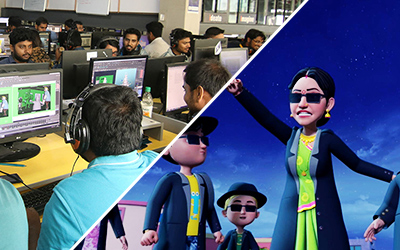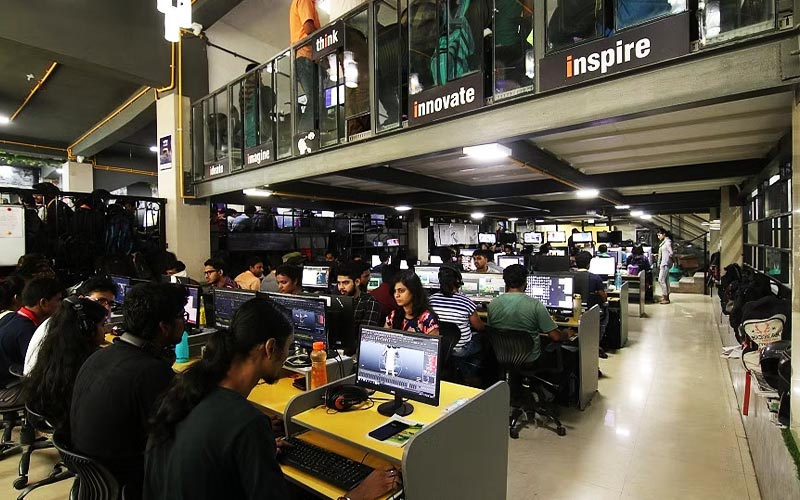
July 10, 2023 #production house #animation studio
Table of Contents
# What does a film production company do?
# What are the five film techniques?
#Why is Hitech Animation regarded as one of the best animation production companies?
# Conclusion
Cinematic experiences that are both fascinating and transformative are mostly produced by film production firms. They combine a wide variety of creative skills, technical know-how, and financial resources to give stories life, escorting viewers to unfamiliar realms and arousing strong emotions.
These businesses are essential to every phase of the production of a movie, from the ideation stage to distribution and beyond. Production businesses craft the storylines that enthral and inspire viewers all over the world with a sharp eye for artistic vision, a commitment to quality, and an awareness of the always shifting landscape of the film industry.
In this introduction, we will explore What does a film production company do and what techniques are used by them.
What does a film production company do?
A film production company is responsible for overseeing and managing the process of creating films, from conceptualization to distribution. Here are some key activities typically undertaken by a film production company:
Exploring New Platforms and Formats:
- With the rise of streaming platforms and online content consumption, production companies are exploring opportunities beyond traditional theatrical releases.
- They are creating content specifically for streaming platforms, web series, short films, and even immersive formats like virtual reality (VR) and augmented reality (AR).
- This allows for greater experimentation and audience engagement.
Nurturing New Talent:
- Film production companies are actively investing in emerging talent and supporting aspiring filmmakers.
- They offer mentorship programs, talent development initiatives, and platforms for showcasing independent films.
- By nurturing new voices and fresh perspectives, production companies contribute to the growth and diversity of the film industry.
Transmedia Storytelling:
- Production companies are embracing transmedia storytelling, where narratives unfold across multiple platforms and mediums.
- They are crafting interconnected stories that span films, television series, webisodes, social media content, and more.
- This approach creates a rich and expansive storytelling universe, enticing audiences to explore different aspects of the narrative and fostering a sense of community and engagement.
User-Generated Content (UGC):
- Recognizing the power of user-generated content, production companies are incorporating UGC elements into their projects.
- They encourage fans to contribute fan art, videos, and creative interpretations, fostering a sense of ownership and co-creation.
- This participatory approach not only strengthens the bond between the audience and the film but also generates a buzz and expands the reach of the project.
Interactive Cinema:
- Production companies are experimenting with interactive cinema experiences, where audiences have agency over the storyline and outcomes.
- Through choose-your-own-adventure narratives or live events with real-time audience interaction, viewers become active participants, shaping the direction of the story.
- This form of engagement blurs the line between spectator and storyteller, heightening the immersion and emotional investment.
What are the five film techniques?
Film techniques refer to the various tools and methods used in filmmaking to create specific effects and convey meaning. While there are numerous techniques employed in filmmaking, here are five fundamental ones:
Camera Angles and Shots:
- Camera angles and shots play a vital role in visual storytelling.
- They determine the perspective from which the audience views a scene and can evoke different emotions and reactions. Some common camera angles include:
Low angle:
- Shooting from a low position, looking up at the subject, often used to make the subject appear powerful or dominant.
High angle:
- Shooting from a high position, looking down at the subject, often used to make the subject appear vulnerable or subordinate.
Wide shot:
- Capturing a broad view of a scene or location, providing context and establishing the setting.
Close-up:
- Focusing on a specific detail or the face of a character, emphasizing their emotions or reactions.
Editing:
- Editing is the process of selecting and arranging shots to create a coherent and engaging narrative.
- It involves manipulating the timing, pacing, and sequence of shots to convey information, build tension, or create visual and thematic connections.
- Techniques like cuts, fades, dissolves, and montage are used to transition between shots and scenes.
Lighting:
- Lighting is a powerful tool that sets the mood, highlights specific elements, and shapes the overall visual aesthetic of a film.
- Cinematographers use various lighting techniques to create different effects, such as:
High-key lighting:
- Bright, evenly lit scenes, often associated with comedies or upbeat atmospheres.
Low-key lighting:
- Dramatic, contrast-rich lighting, often used in film noir or suspenseful scenes.
Backlighting:
- Illuminating the subject from behind, creating a halo effect and adding depth and separation from the background.
Sound Design:
- Sound design encompasses all aspects of a film's audio, including dialogue, music, sound effects, and ambient noise.
- It enhances the viewer's experience by creating atmosphere, establishing mood, and guiding the audience's attention.
- Techniques like sound mixing, layering, and the strategic use of silence can significantly impact the emotional impact of a scene.
Color Grading:
- Color grading is the process of adjusting and enhancing the colors and tones of a film to create a specific visual style or mood.
- It involves manipulating the contrast, saturation, and hues of individual shots or the entire film to achieve a desired aesthetic.
- Color grading can contribute to the overall storytelling by conveying emotions, establishing a specific time period or location, or differentiating between different narrative elements.
These five techniques are just a starting point, and there are many more techniques and tools that filmmakers employ to achieve their artistic vision and storytelling goals. If you want to hire a production company then you can search for "film production companies near me".
Why is Hitech Animation regarded as one of the best animation production companies?

Hitech Animation is regarded as one of the best animation production companies. Hitech Animation has received industry recognition and accolades for their exceptional work. They have won several awards and have been acknowledged for their contribution to the animation industry. This recognition highlights their commitment to quality and their ability to deliver outstanding animation projects.
Conclusion
Film production companies and animation production companies play a crucial role in the creation of captivating cinematic experiences. They bring together creative talents, technical expertise, and financial resources to bring stories to life and transport audiences to new realms of imagination and emotion. These companies are involved in various aspects of the filmmaking process, from ideation to distribution, and they employ a range of techniques to enhance storytelling and engage viewers.